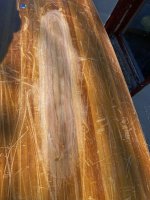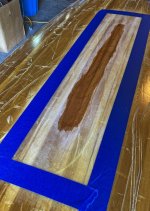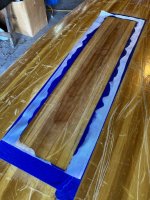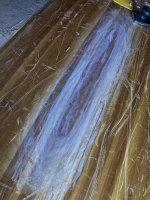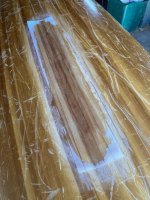Well, not really delamination since the layer of wood cells came with the glass and epoxy. This is my Kite, built in 2016 and documented on this site. This canoe is well used, and well taken care of for the most part. In the years since I built it, the canoe has probably seen 30 days of tripping use each year in the US and Canada, and all the scrapes, knocks and collisions with submerged obstacles and dragging over logs you would expect to encounter on routes that aren't well traveled. It also gets close to that many days of use in the area where I live, mostly paddling cobble/gravel bed rivers. Late last summer I did a trip to northern Saskatchewan and the canoe got shredded a little, mostly shallow scratches, but also a deeper gouge here and there. This spring I did a good sanding and varnish job on the bottom.
One month ago I headed to Minnesota and spent 2 weeks in the boundary waters, then went up to Wabakimi for another 10 day trip. Right off the bat I noticed a dark area forming on the bottom, which I knew was water intrusion. Later I could see water was trapped there, but could also see another area bulging up that had no water intrusion. At some point I paddled over a submerged rock and was able to see the fiberglass was ripped in the dark area, so I slapped on a strip of gorilla tape and forgot about it until I returned yesterday.
The pictures below tell the story. My assumption is that all the impacts have essentially made the wood fail beneath where the epoxy had penetrated, which is almost nothing by the way. Does anyone know if this a common mode of failure with strip canoes? My repair solution will be to simply build up epoxy and glass to fill the spots, but I'm wondering if I should add a new layer of glass to the bottom afterwards. As built, I have a 6oz and 4 oz layers of e-glass there already. The new layer would be 4oz s-glass.
I am pretty sure I got all the delaminated glass off in this section, but there are at least 2 more areas I have yet to cut into. Any suggestions or observations from you guys?
Thanks, Mark
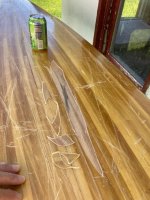
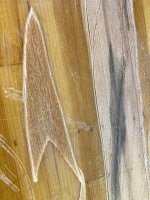
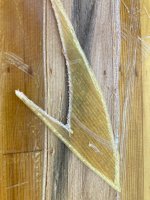
One month ago I headed to Minnesota and spent 2 weeks in the boundary waters, then went up to Wabakimi for another 10 day trip. Right off the bat I noticed a dark area forming on the bottom, which I knew was water intrusion. Later I could see water was trapped there, but could also see another area bulging up that had no water intrusion. At some point I paddled over a submerged rock and was able to see the fiberglass was ripped in the dark area, so I slapped on a strip of gorilla tape and forgot about it until I returned yesterday.
The pictures below tell the story. My assumption is that all the impacts have essentially made the wood fail beneath where the epoxy had penetrated, which is almost nothing by the way. Does anyone know if this a common mode of failure with strip canoes? My repair solution will be to simply build up epoxy and glass to fill the spots, but I'm wondering if I should add a new layer of glass to the bottom afterwards. As built, I have a 6oz and 4 oz layers of e-glass there already. The new layer would be 4oz s-glass.
I am pretty sure I got all the delaminated glass off in this section, but there are at least 2 more areas I have yet to cut into. Any suggestions or observations from you guys?
Thanks, Mark




